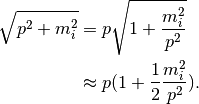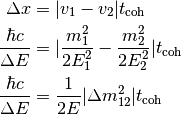Vacuum Oscillation¶
Schrodinger equation is

where for relativistic neutrinos, the energy is

in which the energy terms are simplified using the relativistic condition

So Called Decoherence
Here we assume that they all have the same energy but different mass. The thing is we assume they have the same velocity since the mass is very small. To have an idea of the velocity difference, we can calculate the distance travelled by another neutrino in the frame of one neutrino.
Assuming the mass of a neutrino is 1eV with energy 10MeV, we will get a speed of  c. This
c. This  c will make a difference about
c will make a difference about  in 1s.
in 1s.
Will decoherence happen due to this? For high energy neutrinos this won’t be a problem however for low energy neutrinos this will definitely cause a problem for the wave function approach.Because the different mass eigenstates will become decoherent gradually along the path.
A estimation of the decoherence length is

To obtain the relation,

It should be made clear that this is not really decoherence but in the view of wave packet formalism different propagation eigenstates will be far away from each other. As long as we put them together again we can overlap and oscillate again. No quantum decoherence is happening at all.
In general the flavor eigenstates are the mixing of the mass eigenstates with a unitary matrix $mathbf U$, that is

where the  s are indices for flavor states while the $i$s are indices for mass eigenstates.
s are indices for flavor states while the $i$s are indices for mass eigenstates.
To find out the equation of motion for flavor states, plugin in the initary tranformation,

We use index :math:{}^{vm}$ for representation of Hamiltonian in mass eigenstates in vacuum oscillations. Applying the unitary condition of the transformation,

I get

which is simplified to

since the transformation is time independent.
The new Hamiltonian in the representations of flavor eigenstates reads

Survival Problem¶
The neutrino states at any time can be written as

where  and $X_2$ are the initial conditions which are determined using the neutrino initial states.
and $X_2$ are the initial conditions which are determined using the neutrino initial states.
Survival probalility is the squrare of the projection on an flavor eigenstate,

The calculation of this expression requires our knowledge of the relation between mass eigenstates and flavor eigenstates which we have already found out.
Recall that the transformation between flavor and mass states is

which leads to the inner product of mass eigenstates and flavor eigenstates,

The survival probability becomes

 stands for the $i$th row and the
stands for the $i$th row and the  th column of the matrix
th column of the matrix  .
.
Two Flavor States¶
Suppose the neutrinos are prepared in electron flavor initially, the survival probability of electron flavor neutrinos is calculated using the result I get previously.
Electron neutrinos are the lighter ones, then I have  and denote
and denote  .
.
Meaning of Mixing
In the small mixing angle limit,

which is very close to an identity matrix. This implies that electron neutrino is more like mass eigenstate  . By
. By  we mean the state with energy
we mean the state with energy  in vacuum.
in vacuum.
In fact the dynamics of the system is very easily solved without dive into the math. Suppose we have  initially, which is
initially, which is

the state of the system at distance  is directly written down
is directly written down

Since a global phase doesn’t change the detection, we write the state as

Notice that the period of the expression is

Then the state becomes

The survival probability for electron neutrinos is
